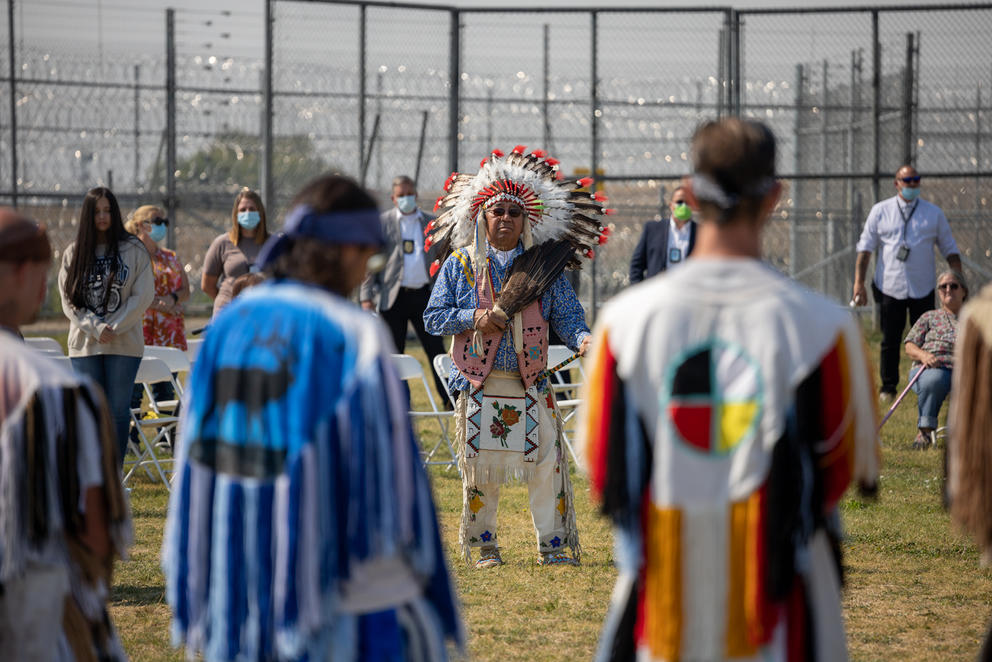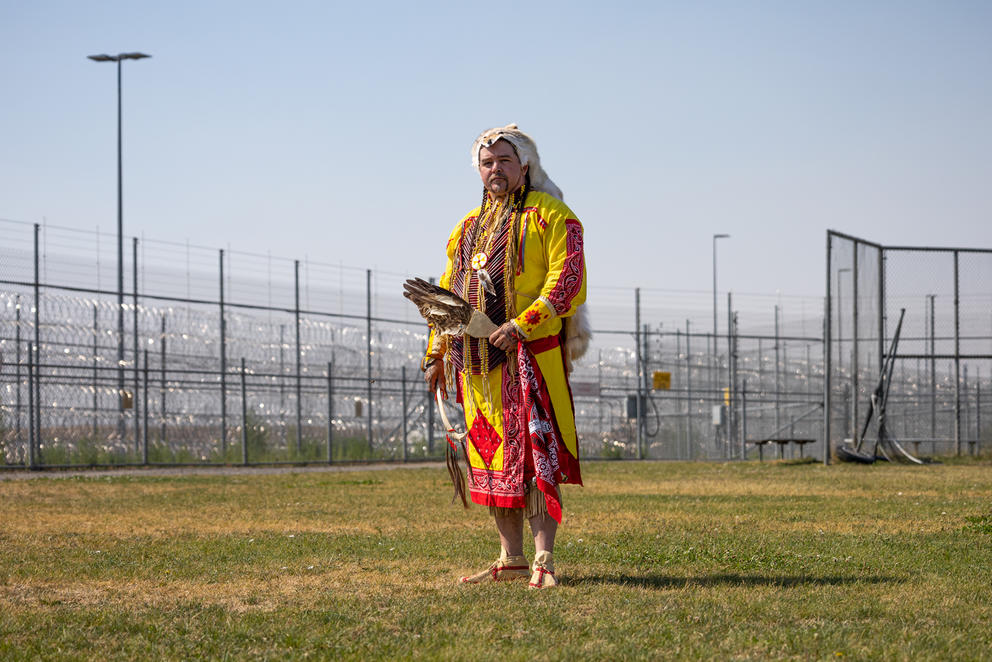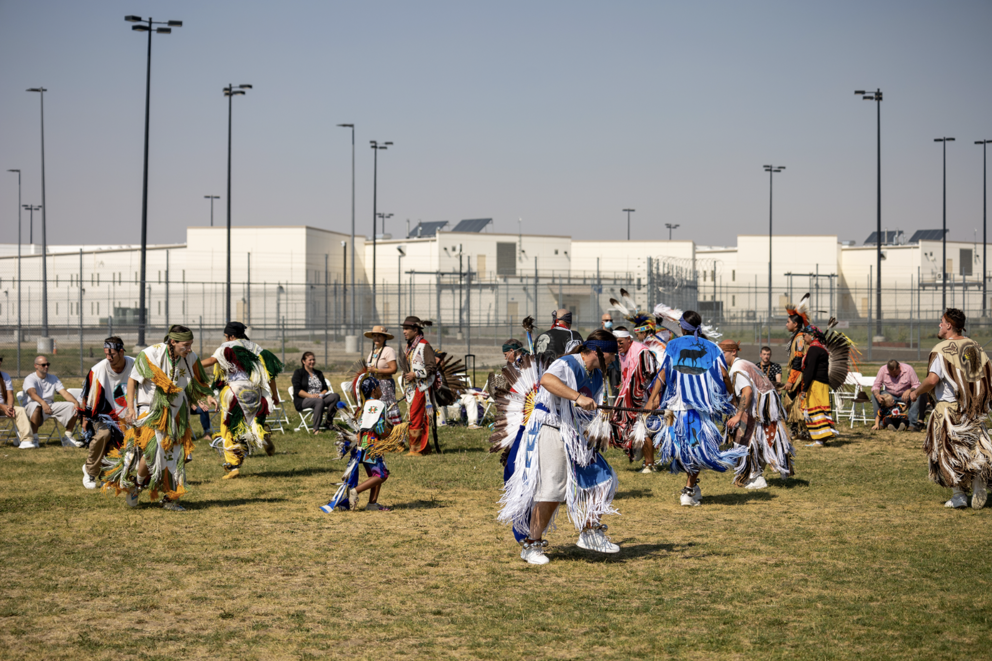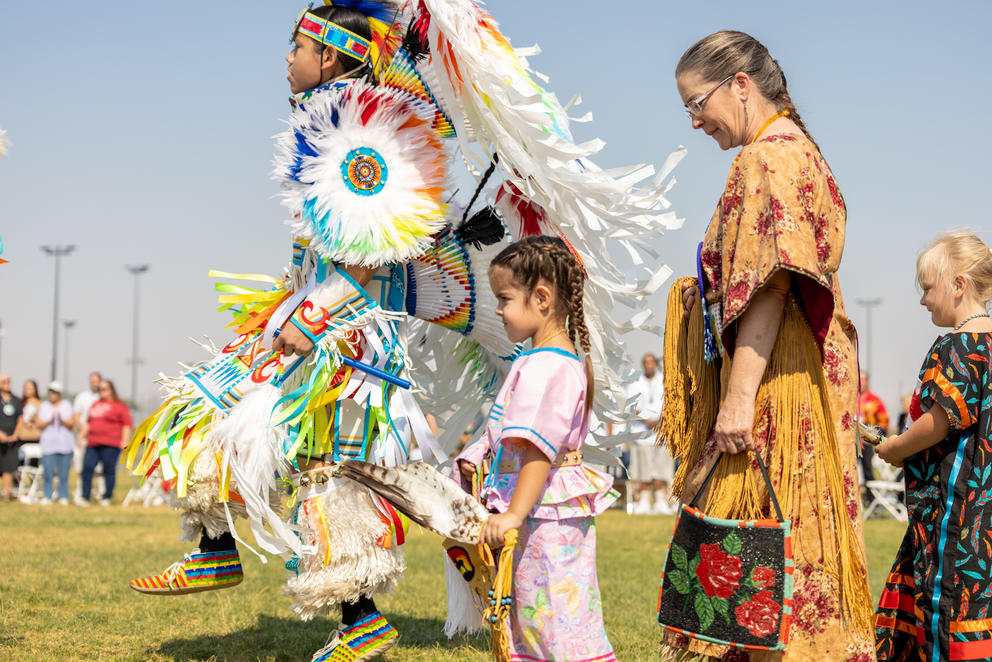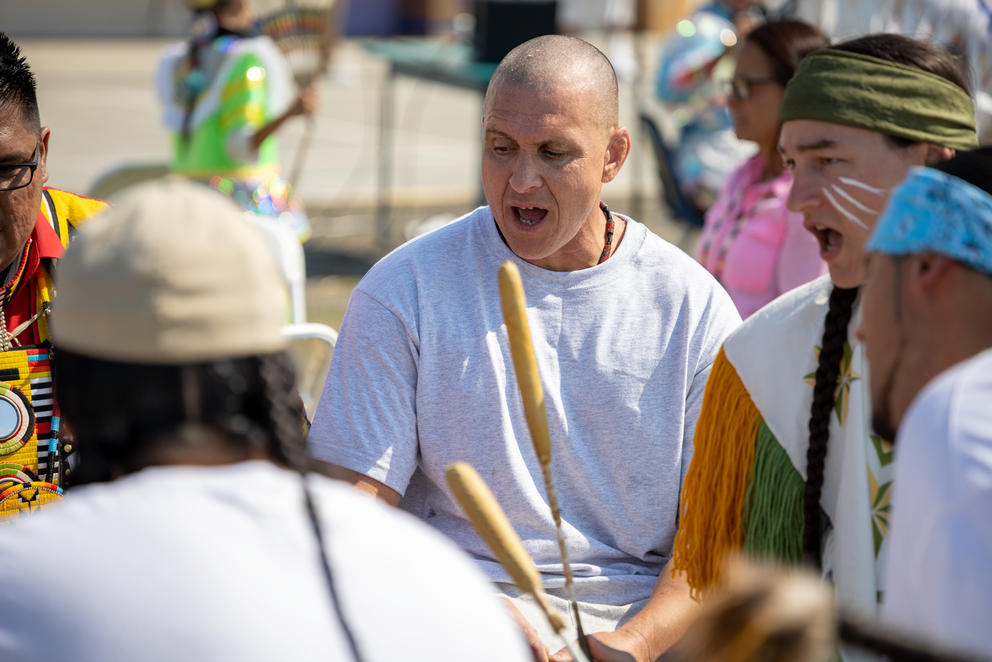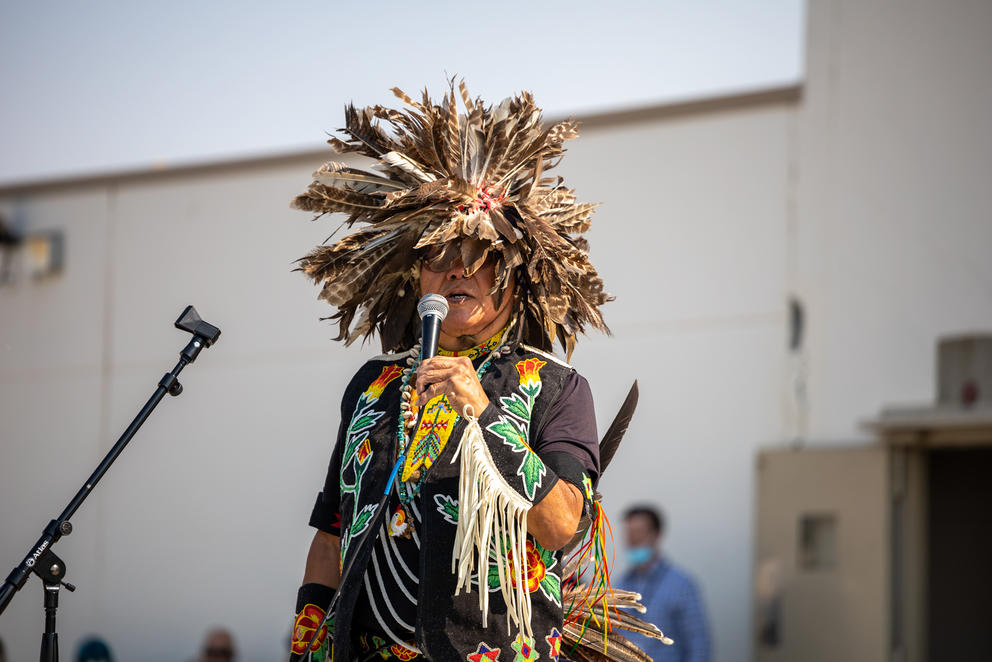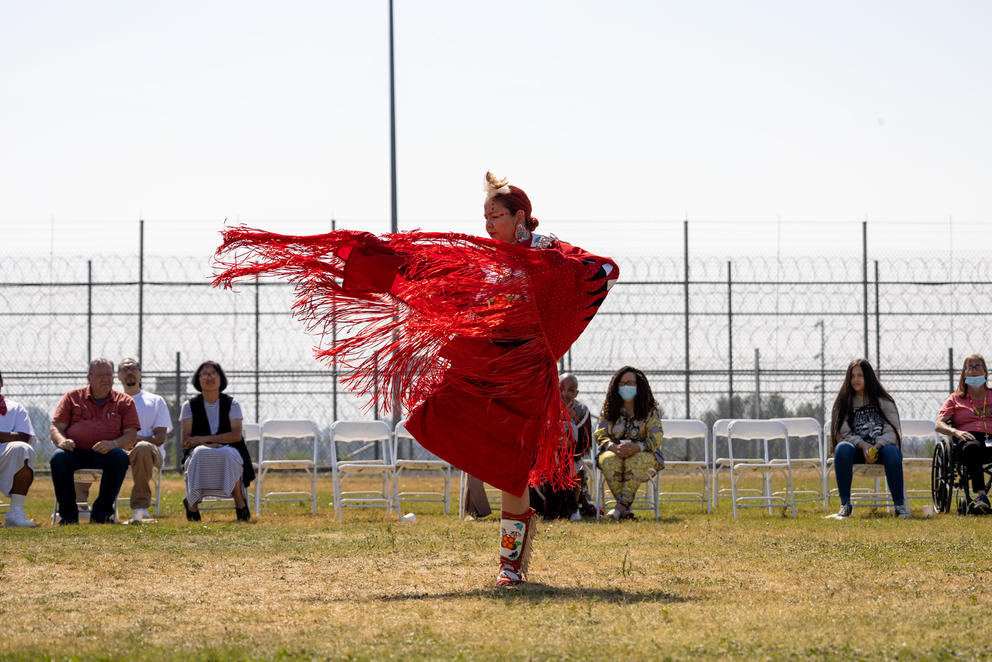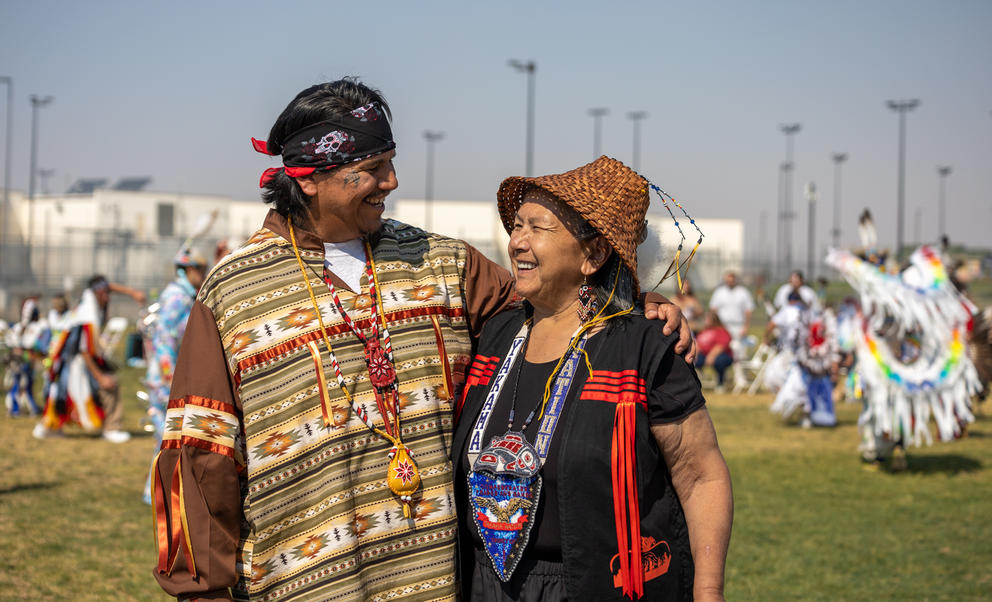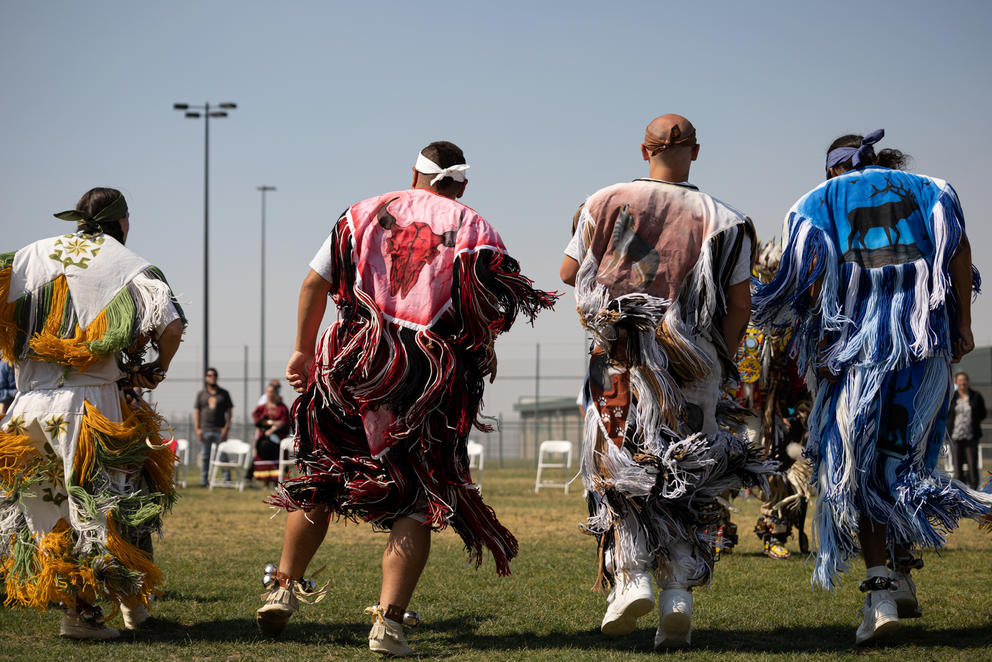But most of the dancers that day were dressed in identical khakis and white T-shirts. They moved to the beat of the drums, surrounded by their families and supporters. Outside that ring stood rows of chain-link fences topped with razor wire.
On Sept. 8, Native American prisoners at the Washington State Penitentiary in Walla Walla hosted their first powwow in three years, a 50-year tradition temporarily halted by the COVID-19 pandemic.
“Today is a big day, to be able to see our families,” said Yakama inmate Tallon Saluskin. “And to get to show love.”
Thirty-seven Indigenous inmates and 75 guests attended the first of 22 powwows scheduled for September and October in Washington state prisons. It was the first time the Washington State Department of Corrections allowed an outdoor powwow in a medium-security prison. There was drumming and dancing, plus a feast of salmon, buffalo stew and fry bread. Late in the afternoon, prisoners presented handmade gifts to nearly every attendee.
Joey Brooks, Lakota, has participated in four powwows during his incarceration at Washington State Penitentiary. He credits a reconnection to his culture for guiding him in the right direction. "No matter how far you get off the path, the medicine will bring you back,” Brooks said on September 8, 2022. (Jarrette Werk/Underscore News)
Joey Brooks, a Lakota inmate, grew up on the Navajo Nation. He said the September event was his fourth powwow at the prison in Walla Walla.
“We come together to try and show our family that we’ve let down that we can change,” Brooks said. “And that we’re trying to change.”
The lack of powwows, sweat lodges and other Native American religious ceremonies during the pandemic made a difficult time period even harder, according to Jeremy Garretson, Northern Arapaho, Indigenous Reentry Program Manager at Unkitawa. The organization’s name is a Lakota word that means “ours, yours and mine” and conveys the concept that what appears to be individual must be cared for collectively.
“Without access to prayer, you’re dealing with a completely different individual,” Garretson said.
Jeremy Garretson, Northern Arapaho, serves as the Indigenous Reentry Program Director at Unkitawa, a nonprofit centered in traditional practices to help heal and support communities through ceremony, art and culture. Garretson, who was formerly incarcerated himself, now assists Native circles in Washington prisons. (Jarrette Werk/Underscore)
That painful stretch of time devoid of religious ceremonies ended sooner for prisoners who participated in other religions, even though Native Americans are incarcerated in the United States at higher rates than any other racial category, after African Americans. Though they make up 1.9% of the population of Washington, nearly 5% of the people jailed in state prisons in Washington are Native American.
“We just have too many of our young men and also women in the prison system,” said Shelly Boyd, a Sinixt member of the Arrow Lakes band of the Confederated Tribes of the Colville Reservation and a guest at the September powwow. “And everyone that comes in here, they bring a little piece of their family here with them.”
COVID restrictions in prison were especially detrimental to Indigenous faith practices, according to attorney Gabe Galanda, founder and chairman of Huy (pronounced “Hoyt”), a nonprofit that advocates for Indigenous prisoners.
“You can’t distance inside a sweat lodge the way you can during a mass or some other form of religious worship,” said Galanda, a member of the Round Valley Indian Tribes.
Restrictions under the pandemic caused an absence of ceremony comparable only to one other period of time since officials in Washington State first allowed them at least 50 years ago: In 2010, the Washington Department of Corrections (WDOC) sharply curtailed the Indigenous faith practices it allowed. At issue were budget cuts and a dispute over whether to allow children to attend powwows.
But the religious rights of Indigenous prisoners are protected under the First Amendment, the American Indian Religious Freedom Act of 1978 and rulings from the U.S. Supreme Court, including the 1979 case Bell v. Wolfish, which found that prisoners "do not forfeit all Constitutional protections by reason of their conviction and confinement in prison.”
Ten tribes petitioned the governor for a reversal of the 2010 policies, but it took over two years for the WDOC to restore Native prisoners’ religious rights.
In the spring of 2010, Galanda helped a Tulalip tribal member regain his job as Native chaplain when the WDOC fired him for trying to bring in tobacco for use during a change-of-seasons ceremony.
At the September powwow, Galanda said his own father had been imprisoned in Washington when his mother was pregnant with him.
Because of that history, Galanda said, the 2010 phone call from a Tulalip tribal attorney asking him to help the fired Native chaplain changed his life and spurred him to form Huy.
“At the time,” Galanda said, “my wife was pregnant with my daughters and I had just started a law firm. We took on this work because it was what Creator asked me to do.”
In the Coast Salish Lushootseed language, “Huy” means “See you again/We never say goodbye.”
Since then, Huy has worked as a watchdog for Indigenous prisoners, winning court battles and appeals across the country and delivering intercessions to the United Nations.
Sometimes, like when heightened COVID restrictions prevented Indigenous sweat lodges, Huy used a softer approach.
“Through diplomacy we were able to work through those things,” Galanda said.
Children were able to attend the event in September because of an agreement Huy forged with prison officials. Huy donated money to cover the cost of additional security needed to hold the event and to pay for the feast.
“In general, Indigenous religious and cultural opportunity is a proven way to allow our relatives to heal and obtain redemption,” Galanda said. “It is also a proven way to reduce infraction and recidivism. So it’s a win-win for everyone involved in corrections to allow our relatives to do what they’ve always done religiously and spiritually."
‘We try to help you find your way’
Within the 12 Washington state prisons there are 21 “hoops,” or Native religious circles. Each hoop is self-organized and self-governed. And they get legal and practical support from Huy and Unkitawa.
“They organize themselves culturally and religiously and we try and support them when there is a concern of law,” Galanda said.
At the Washington State Penitentiary, the South Complex Circle can currently attend a sweat lodge ceremony twice a month and a drumming circle twice per week. When they’re preparing for a powwow, drumming circles get bumped up to three times per week.
Jarrod Airington, a Quinault inmate, said part of the hoop’s purpose is to help Indigenous prisoners connect with their traditional cultural practices.
“If this is the walk that you want to walk, you come to the hoop and we try to help you find your way, because we all have different beliefs in our own nations,” Airington said. “This is just a starting point.”
Airington is also in charge of the prison medicine garden. There, hoop members tend plants from seed to harvest, then braid sweetgrass and sift lavender flowers to make the medicine they use for smudging, in sweat lodges and for pipe ceremonies.
“A lot of these guys, they come from the cities and they were never a part of that,” Airington said.
Galanda sees the medicine garden as an accessible religious activity that could be replicated in prisons around the country and all over the world.
And for prison officials, growing herbal medicines within the prison’s walls prevents contraband from hitching a ride in.
“If we can keep it in-house, we can control it,” said Don Holbrook, assistant secretary of the Men’s Prisons Division for the Washington State Department of Corrections. “That’s not really what it’s about, though. It’s about giving these guys something to look forward to.”
‘My prayers are with my brothers here’
Presiding over the September event was the most instrumental prison hoop leader in the state. But after 35 years, this could be his last powwow as a prisoner.
Herbert “Chief” Rice leads the South Complex Circle. Rice was convicted of murder at age 17 and is serving two consecutive life sentences. But the U.S. Supreme Court ruled in 2012 that life sentences for juveniles are unconstitutional. Rice is scheduled for resentencing in December, when he could be released.
Joey Brooks, the Lakota inmate, said Rice’s possible release increased the significance of the September powwow.
“Herbert Rice has been a pretty big role model,” Brooks said. “If he gets out, it’s going to be left to one of us. And I hope he does get out. Because he’s going to be a big help to us out there.”
Prison officials asked Underscore News not to quote Rice, and to include only the voices of the three prisoners they had designated for interviews.
“Every time I go into my sweat lodge, my prayers are with my brothers here,” said Francis Cullooyah, an elder of the Kalispel Tribe and retired religious coordinator for the Washington State Department of Corrections. He attended his first powwow at the Washington State Penitentiary 30 years ago. (Jarrette Werk /Underscore News)
Francis Cullooyah, an elder of Kalispel Tribe and retired religious coordinator for the Washington State Department of Corrections, delivered the opening prayer at the September powwow.
“Every time I go into my sweat lodge, my prayers are with my brothers here,” Cullooyah said.
Cullooyah helped build sweat lodges at the prison three decades ago. He said his daughter, Tawny Cullooyah, dancing that day in white and blue regalia, was just 4 when he helped prisoners at Walla Walla put on the prison’s first powwow. At the time, Cullooyah said, he chose to use traditional plateau style for the prison’s sweat lodges and other ceremonies.
"All my little granddaughters were here today, just as my daughter was 30 years ago,” Cullooyah said.
Cullooyah said his work within the prisons has continued after his retirement, largely due to inmate efforts. He continues to volunteer extensively within the prison system.
“Because of Chief’s groundwork inside the prison, I just kept coming back,” Cullooyah said.
‘I’m going to sit here with my mom all day’
Throughout the year, Indigenous prisoners at Washington State Penitentiary work on the gifts they will give to their families and friends at that year’s powwow. At the event in September, tables lined up along the prison’s concrete wall were covered with gifts. Painted drums and beadwork of all kinds were crowded among carved wooden salmon, pipes and medicine pouches. Boxes filled with colorful handmade quilts sat under the tables.
Hoop members presented their families with gifts made specifically for them. At the end of the day, they gave out the extra gifts, with something for almost every attendee.
Tallon Saluskin, Yakama, sat next to his mother at the edge of the dancing area. He said he hadn’t seen her in nearly 10 years.
“She’s not able to drive that well,” Saluskin said.
He gave his mother a leather pouch decorated with beaded hummingbirds. He and two other inmates had made the pouch and adorned it with beads by hand.
Edith Marie John, Puyallup, turned the pouch over in her hands as she displayed it.
“There’s a story to this,” she said. “When my mother was dying she came to us as a hummingbird. She gave us a sign that she was ready to go.”
Saluskin smiled as he watched his mother hold his gift.
“Every bead we put on, we think of moments we were together and put it into this piece, and when she gets it, she’s able to feel that medicine,” Saluskin said.
He said he didn’t plan on dancing during the powwow.
“No, I’m going to sit here with my mom all day,” Saluskin said. “I probably won’t move.”
Saluskin’s mother said events like these are important to help prisoners connect to their communities and stay out of jail when they’re released. According to data from the Washington Department of Corrections, more than 45% of Native American prisoners in the state return to prison within three years of their release. That compares to an overall recidivism rate of 30% within three years.
“They say half of the people who get out come back and I think that’s because they don’t have support,” John said. “They don’t have family or community. Tallon had that, too, because I learned the hard way. Because I used to do drugs. But I’ve been clean for years now and that feels good.”
‘The medicine will bring you back’
Brooks said the hoops aren’t supported by all prison staff.
“There’s some staff that don’t want this.,” Brooks said. “They’re ignorant to our ways. They’ve said, ‘They shouldn’t be allowed to do war dancing.’ But it’s not war dancing. What we’re doing is walking in the footsteps of our ancestors.”
But he said staff support has grown over the years.
“There’s always been that racism, but I think they’re realizing this is what’s going to keep us from reoffending,” Brooks said.
He said his lack of participation in his religion was part of what brought him to where he is now. For many, he added, it points a way out.
“Were you out there powwowing? Were you out there ceremonying?” Brooks asked. “The answer is no and this is the result, coming here. But we say no matter how far you get off the path, the medicine will bring you back.”
This story was produced for Underscore News on Sept. 22, 2022 and is republished here with permission.

